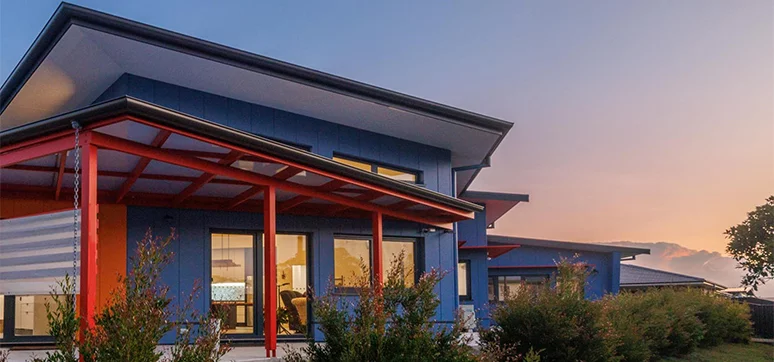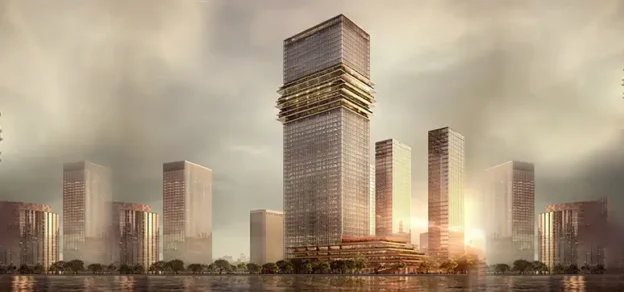A home located in Northern New South Wales, Australia, near the Richmond River in Ballina, a certified ‘classic’ passive house home has been built. It has been recently awarded the “Smart Building Ideas: Innovation” winner, sponsored by Verosol, from the Australian Architecture & Design national Sustainability Awards 2022. This location is considered sub-tropical locally (warm temperate to PHI) where the midges and mosquitoes are required to be kept out of buildings with fly screens and termites kept away through construction methods and materials.

The site environs, aspects, and typology fused with a detailed client brief contributed to the final home design. With aging in place and accessibility a high priority, spaces and ideas developed into functional elements that have proven to work well post construction. Defined as an irregular heptagon (boot-shaped) site creates design challenges, and forms part of the characteristics of the key site. Entering off a cul-de-sac with a stormwater bio-retention cell to the left front side of the site which must not be built over or altered in any manner located in a flood zone, narrowed the access and vehicular turning circles at the property frontage.
Generally, the site is flat with a 5.0m easement to the northwest which falls to the boundary with a height difference of 0.6m to a concrete swale drain. The northeast of the site is constrained by a 5.0m easement which falls approximately 1.80m over 7.0m, then falls to a concrete swale drain. Built with timber construction and boldly finished externally, this home invites curiosity. The interior is lowkey with a more relaxed atmosphere, it caters to an owner who likes to entertain and have guests stay.
The bulk insulated timber framed dwelling is the first residential building in Australia to be fully built with structural OSB-3 covered with ProClima Adhero adhesive water resistant airtight barrier, followed by continuous Steico wood fibre insulation. A ventilated cavity exists around the whole building cladding (walls and roofing) to the ventilated ridge line which enables the building to use convection to keep the cavity and outsulation (the external wood fibre panels) dry.
The home has been recently La Niña stress tested in March 2022 due to the flooding in Ballina, surviving most negative impacts from flood waters. The additional humidity has seen the dehumidifier run for an additional month to keep the interior comfortable. Presently, the previously vacant bedroom is now a temporary home to a couple of (senior) flood refugees while their own home is repaired (at the time of writing).

These folks have learned how comfortable, quiet and accessible this home is. With a learning curve for all – for example, as the windows were opened at times because that is what they normally do for fresh air, it had to be explained how the home operated, and when the best time for opening windows was (when it isn’t too humid or too hot outside). This has become easier for them to understand as the weather has cooled, and living with no heating is required internally being described as “a different world, in there” when they step out.

Approached with an originally drafted design by the clients’ father, himself an architect, BluKube Architecture resolved to turn it into a Passive House design. The redesign involved a detailed brief and developed architectural plans for a three-bedroom plus media room, living room, kitchen, laundry, two bathrooms, and ensuite dwelling with a double garage. The design incorporates features for aging in place, including a wheelchair-friendly layout, step free entries, wider doorways, and a separate self-contained guest wing so the client could have a housemate or a carer as life changes. The two-car drive through garage has north-facing solar photovoltaic panels on the roof and is EV-charging ready.
There was no Passive House certified builder established with prior experience in the Ballina area, several custom builders were interviewed prior to the contract being awarded. One builder could see the advantages of building better and became a certified Passive House Tradesperson, this greatly benefited the project outcomes.
There were changes in the design at the approval stage due to easement correction, which altered the northern design intentions of outdoor use. Creating a larger than intended edge beam to the northeast which had to be insulated, and appropriate flood plain insulation to the slab edge be designed for the application. During construction, communication was an extremely important aspect of this project to ensure that all members of the construction team: the builder, architect, engineer, and other consultants collaborated with the same intentions and goals aimed for by the client. The use of technology made the process possible with the ability to share files and images that may be required for construction or to resolve any issues, share exciting moments (ie: airtightness test results shared via online meeting), and challenges that may have occurred. This was fundamental in ensuring any changes to materials met the requirements for Passive House goals.

Being creative with door threshold insulation on the slab using an EPDM rubber with low U-Value that was fixed to the slab and enabled tiles to be laid on top without cracking and still leaving room for the sills to drain water. The builder was happy to warrant this solution.
This enabled continuous insulation to slab edge and low fRsi value. In turn meeting the requirements of the Passive House Standard for thermal bridging at the wall and floor junction for warm temperate environments reducing the impacts of mould production.
Products used to create this sustainable project are:
- Timber frame & timber trusses
- Wood fibre Steico 60mm thick insulation boards
- Earthwool R2.7 bulk insulation batts
- Tilt & Turn Windows & Tilt and Slide Doors
- Neuffer uPVC double glazed
- Aluplast 5000 TS
- Uw-value 1.55 W/(m2K)
- Uf -Value 1.02 W/(m²K)
- g–Value 0.65
- Ug -Value – 1.12 (W/m²K)
With Swisspacer Ultimate warm edge spacers
- Weather-resistant membrane & air barrier Proclima Adhero to achieve excellent blower door test result of 0.1ACH@50Pa.
- Recycled orchard netting to prevent bulk insulation movement at the top chord of trusses
Energy efficient Ventilation appliance units include:
- Stiebel Eltron GmbH & Co. KG
- Germany – LWZ 280 (Balance) Air handling unit with heat recovery – STD
- Heat recovery efficiency 0.84
- 0.27 Wh/m³ Electrical efficiency


• Daikin US-7 AC/dehumidification
75% Humidity recovery efficiency
2.5 Wh/m³ Electrical efficiency
• ISODrive 900 Schweigen Silent RangeHood
0.57 Wh/m³ Electrical efficiency
• Makeup Air TT Pro 200 Inline axial fan
1.08 Wh/m³ Electrical efficiency
• Hot Water: Sanden heat pump with storage tank outside the thermal envelope
The Passive House Planning Package (PHPP) 9.6 was used to complete the energy performance analysis requirements of the dwelling. Through modification of the typical wall type that is taught to be used in cool climate Passive House projects, a more suitable climate building envelope was designed after analysis of WUFI (hydrothermal) data and investigating products available in the marketplace.
Other features that were designed into the building were:

• The home has an internal treated floor area of 220sqm (for context)
• Spacing heating demand of 4.62 kWh/(m2a) according to PHPP
• Cooling & dehumidification demand of 8.17 kWh/(m2a) calculated according to PHPP
• Has a primary energy renewable (per) of 39 kWh/(m2a) on heating installation, domestic hot water, household electricity, and auxiliary electricity calculated according to PHPP
• Generates 34 kWh/(m2a) of renewable Energy through the photovoltaics based on the projected area according to PHPP
• Non-renewable Primary Energy (PE) of 83 kWh/( m2a) on heating installation, domestic hot water, household electricity, and auxiliary electricity calculated according to PHPP
• An airtightness pressurization test result of 0.1ACH@50Pa, the average Australian home presently is 15.5ACH@50Pa, Passive House standard requires < 0.6ACH@50Pa.
• Has a mechanical ventilation and heat recovery unit that runs 24/7 at minimal cost rated at a value of 84% efficiency by the Passive House Institute in Germany
• Double-glazed thermally broken uPVC Alu-clad windows with a low U-value W 1.55 W/(m2K) and warm edge spacers

• Slab edge insulation at the building perimeter
• Concrete slab U-Value 6.29 W/(m2K), is coupled with the earth to allow heat transfer
• Wall and Roof U-Values are 0.292 W/(m2K)
• Has a ventilated wall and roof cavity to enable moisture to evaporate
• Any external slabs where the engineer required reinforcement back to the primary structure were done in a thermally broken manner using fibreglass rods and strip insulation to prevent thermal bridging.
Other interesting facts about this project are:
• It attracted scrutiny by the local planners, certifiers, and other builders in the area who were keen to learn more about what building better was.
• Was tested during the time of the flood in early 2022, the site was minimally impacted and a watermark of the flood height can be found on the edge beam of the northeast façade of the dwelling.
• It is the first home in the Ballina local government area designed and delivered to certified Passive House Classic standards. Receiving this certified notification on the day the suburb (including this home) was informed residents must evacuate due to the flood waters.
Lessons learned, include:
• It is not too late to improve designs to be more sustainable, going above and beyond minimum code standards where possible is essential to the future-proof building stock.
• Form factor matters when it comes to thermal bridges and material use.
• The fewer external angles in either the horizontal or vertical planes can make a big difference to a sustainable outcome.

• Passive house is a great stepping stone to aim for net zero, and can be combined with many other design tools (ie: GBCA’s variety, Living Building Challenge, WELL standard) to have even better outcomes that add to the already low energy objectives that are the foundations to passive house.
• Being an architect at this time as the industry makes this transition is a very exciting time to use all the knowledge available to make a change now and to improve the future of buildings.
We need to keep breathing fresh filtered air in a building that is very nice. Air balancing in a building takes time and patience combined with excellent communication, clients need to understand the importance of this and that they should not alter elements of their building without consulting a professional. In the future, I look forward to using the Passive House Planning Package combined with other tools for embodied energy and life cycle analysis will create even more sustainable net zero buildings, and hope others look to doing so also.
FACT FILE
Location: Ballina NSW AU
Client: G Denniss
Other Consultants:
• Builder: Scholten Group Pty Ltd
• Passive House Designer: Kylie Mills
• Structural Engineer: Ardill Payne
• Ph Certifier: Sustainable Engineering Ltd
• Blower Door Test: Air Tightness Testing Services Australia Pty Ltd
Commencement Date: July 2020
Completion Date: November 2021
Materials Used:
• Timber Frame, timber trusses & rafters
• Earthwool R2.7 bulk insulation batts (within studs)
• Earthwool R2.7 bulk insulation batts (within studs)
• OSB-3 13mm
• Proclima Adhero Weather resistant membrane & air barrier to achieving excellent blower door test result of 0.1ACH@50Pa.
• Wood fibre Steico 60mm thick insulation boards (exterior)
• Vertical & horizontal timber battens
• Scyon Stria 405mm x 4200mm x 14mm boards to external walls
• Tilt & Turn Windows & Tilt and Slide Doors: Double glazed thermally broken uPVC alu-clad windows with a low U-value W 1.55 W/(m2K) and warm edge spacers














